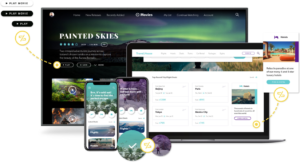Democratizing Your CI/CD Pipeline With Taplytics

Move fast and break things are part of the startup culture. And why not—in the fast-paced world of technological innovation and venture capital, people are constantly chasing the next big thing. But what if there was a way to help your team move faster without breaking anything? Using a CI/CD pipeline helps you do just that.
The acronym CI/CD stands for continuous integration and continuous deployment. Organizations use this framework to refine their product development process for their team. Think of it as the underlying structure for building, testing, iterating, and launching products or features for your customers.
Building out a CI/CD pipeline gives stakeholders throughout your organization the autonomy they need to create more value for customers at scale. When every member of your team participates in product development in a more meaningful way, it helps you build faster. And that speed won’t impact the quality of your products or add additional stress to your team.
Streamline Rollouts Using a CI/CD Pipeline
Rolling out a new product or feature to users is one of the most critical touchpoints in the product experience. It sets the stage—giving users their first impression of your product and its value. When you go about this process through the lens of a CI/CD pipeline, it helps your team deliver value to customers on an ongoing basis without causing burnout or other issues.
With feature flags through Taplytics, you give every member of your team the power to facilitate these rollouts as well. You’ll be able to define your target audience to test new features and roll out functionality slowly and rollback easily in case of any problems or bottlenecks.
Explicit targeting reduces the risk of botching the release experience while also making it easier for your team to keep track of changes. The CI/CD process relies on your ability to experiment and iterate on an ongoing basis, so providing more control makes adopting new ideas and making updates much less stressful. When you provide this functionality to members throughout your organization, it also puts stakeholders closer to their results.
This decreased risk combined with an increase in engagement makes it easier for your team to mold their individual workflows around the CI/CD pipeline—while also alleviating confusion and increasing autonomy throughout your organization.
Save Time and Resources Throughout Your Team
Building out a CI/CD pipeline helps you move faster by freeing up resources throughout your organization. This is especially important for developers, who are often tasked with creating the functionality for experimenting with and rolling out features for your team. With Taplytics, you give the power to build and analyze tests, as well as release features, to the teams directly responsible for those tasks.
You increase institutional knowledge and help more members of the team feel engaged with product launches when you democratize the release management process. Developers will see the underlying logic behind your product goals, marketers will be able to track progress toward upcoming announcements, and product managers will have an easier time refining workflows for maximum efficiency.
That makes building, analyzing, and iterating through each release as seamless as possible for everyone involved.
Increased knowledge drives innovation through your organization and cuts down on the time it takes to come up with new product ideas. Stakeholders across every team will have the customer insight and data they need to anticipate needs in the market and provide value to the business.
When every member of your team understands how their work contributes to your product goals, they’ll have an easier time buying into these ideas as well.
They’ll have control over their part of the process and the autonomy to build workflows around shared goals. Project ideas and requirements will be more specific, and timelines will be more attainable—all while always maintaining a clear view of how that work contributes to larger product goals.
Increase Engagement by Making Experimentation a Team Sport
Your CI/CD pipelines rely on experimentation and testing to create continual value for your customers. No-code tools like Taplytics make building this culture of experimentation easier by putting control in the hands of key stakeholders throughout your team. There’s no better way to increase engagement throughout the product development lifecycle and foster empathy for customers.
No-code tools also take a lot of the fear and confusion out of building practical tests at scale. Whether they’re collecting feedback on a new feature or tweaking the messaging around your product release, every member of your team can easily participate in A/B tests and product experiments.
This team-wide engagement increases visibility into product decisions and helps your team execute their daily tasks without losing sight of the bigger picture.
These experiments are an essential part of innovation and help your team acquire the kind of deep customer insights that make executing toward a shared goal much less complicated. When everyone works together in this way, it rallies the team around a shared sense of ownership—a prerequisite for open and honest feedback. This builds trust throughout your organization and helps create a cohesive product strategy and shape your team into a truly product-led organization.
Making testing and experimentation processes a team sport also brings people closer to valuable customer data, which they can use to refine their thinking around the product experience. It democratizes the decision-making process by making it easier for everyone to contribute their ideas to your product process. The ability to create tests and analyze data increases your institutional knowledge and helps each person have informed and smart conversations about your business’s evolution.
Use Your CI/CD Pipeline to Launch Innovative Products as a Team
Building out a CI/CD pipeline helps your team build, release, iterate, and refine the product experience faster without causing additional strain on the team. It increases engagement with your product development process, increases visibility into important decisions, and frees up valuable resources throughout your team. When your customers look forward to new and engaging products and features on a continual basis, being able to innovate effectively is a critical part of your success.


